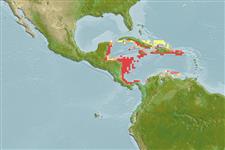Common names from other countries
Environment: milieu / climate zone / depth range / distribution range
Ecologia
; intervalo de profundidade 10 - 50 m (Ref. 129097), usually 30 - 36 m (Ref. 129097). Tropical; 22°N - 9°N, 89°W - 65°W
Western Central Atlantic: The Caribbean Sea from Honduras, Greater Antilles, to the north coast of South America.
Length at first maturity / Tamanho / Peso / Idade
Maturity: Lm ? range ? - ? cmCommon length : 6.0 cm TL macho/indeterminado; (Ref. 344)
Shell thin but strong, circular, moderately inflated, inequivalve. Wing-like projections small. Surface smooth, glossy, but internally with 30 to 40 paired radial ribs. Lower (right) valve more convex than upper (left) valve. Hinge straight. Colour: lower valve cream with light brown rays, upper valve reddish brown mottled with white.
Substrate: sandy mud bottoms (Ref. 344).
Life cycle and mating behavior
Maturidade | Reprodução | Desova | Ovos | Fecundidade | Larvas
Members of the class Bivalvia are mostly gonochoric, some are protandric hermaphrodites. Life cycle: Embryos develop into free-swimming trocophore larvae, succeeded by the bivalve veliger, resembling a miniature clam.
Leal, J.H. 2003. (Ref. 344)
Categoria na Lista Vermelha da IUCN (Ref. 130435)
Categoria CITES (Ref. 108899)
Not Evaluated
Not Evaluated
Ameaça para o homem
Harmless
Utilização humana
| FishSource |
Ferramentas
Mais informação
Idade/TamanhoCrescimentoComprimento-pesoComprimento-comprimentoMorfologiaLarvasAbundância
Fontes da internet
Estimates based on models
Preferred temperature
(Ref.
115969): 27.5 - 28.2, mean 27.7 (based on 10 cells).
